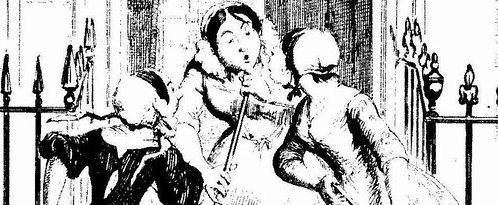The problem of servants
A book that I bought for a couple of its other chapters has greatly helped me to clarify in my own mind the position of women servants in London from the 17th to 20th centuries.
Patty Seleski's chapter on "Women, work and cultural change in Eighteenth- and Early Nineteenth-Century London", paints a picture of a group that belongs very distinctly to the working classes, has few or no emotive ties or investment in their employers, the members of which will change jobs at the drop of a hat, confident in the expectation that it will be easy to get another. They were working class, proud of it and assertive of their rights. Their jobs, however, were not much fun. "Urban domestic service emphasised the social distance between servants and their employers ... [the servants] primarily performed menial and not productive labour within the household ... the domestic drudgery which dominated maidservant's days could not be confused with the duties of a mistress in training." (p. 148)
This is the middle group in the period. The early time, to which this article makes reference, is one I've been exploring, when you tended to have "waiting women" rather than servants, in which, as Seleski puts it:
"Service was almost entirely contiguous with adolescence and young adulthood and it played an important role as a stage in women's lives during which they had an opportunity to learn the secrets of housewifery before they themselves became mistresses." (p. 148)
The final period is hinted at rather than described, but refers no doubt to our traditional view of Victorian "upstairs/downstairs" in which there was a plentiful supply of labour and servants faced a great risk, if they lost their "character", of having no hope of legal employment. They were thus far more in the hold of their employers and forcibly separated from working-class life.
How much nicer to be in the 18th or early 19th-century, when, after you'd decided you'd had enough of one place, you could as did Mary Warnett and Mart Curtain, spend your days idling at a public house in Honey Lane Market, Cheapside, drinking, singing and generally having a good time. "Their flirtatious behaviour led some newcomers to the pub to suspect them of being prostitutes, but the pub's regular customers defended their high-spirits and good-humour as innocent fun. Temporarily out of service, they looked and behaved like others among the labouring poor." (p. 151)
From T. Harris (ed) Popular Culture in England c. 1500-1850, Macmillan, London, 1995, pp. 143-167.







1 Comments:
I've put a bibliography on early modern servants and apprentices online here, if you're interested: http://www.earlymodernweb.org.uk/embiblios/emservantbib.htm - some of them are good on women; I particularly recommend Tim meldrum's work. (And you've reminded me that I sent off an article on the subject several months ago and haven't heard back yet. time to do some gentle chasing... fortunately the editor and I are good friends)
I have an intriguing set of letters written in the 1670s by a young woman, Magdalen Lloyd, from Denbighshire who was working as a servant in London. I don't at the moment know quite what to make of her; I've not had much success in finding out more about her, but I think we're talking minor and impoverished gentry, and possibly the more 'refined' lady's-maid (or, indeed, 'waiting woman') rather than domestic drudgery (but she never goes into what her job entails); OTOH, she mentions her salary at least once and it isn't very high. In the end, she purchases - I think with the help of a legacy - her own holding back in Wales (and runs it herself as a single woman for a while at least).
Sharon.
Post a Comment
<< Home